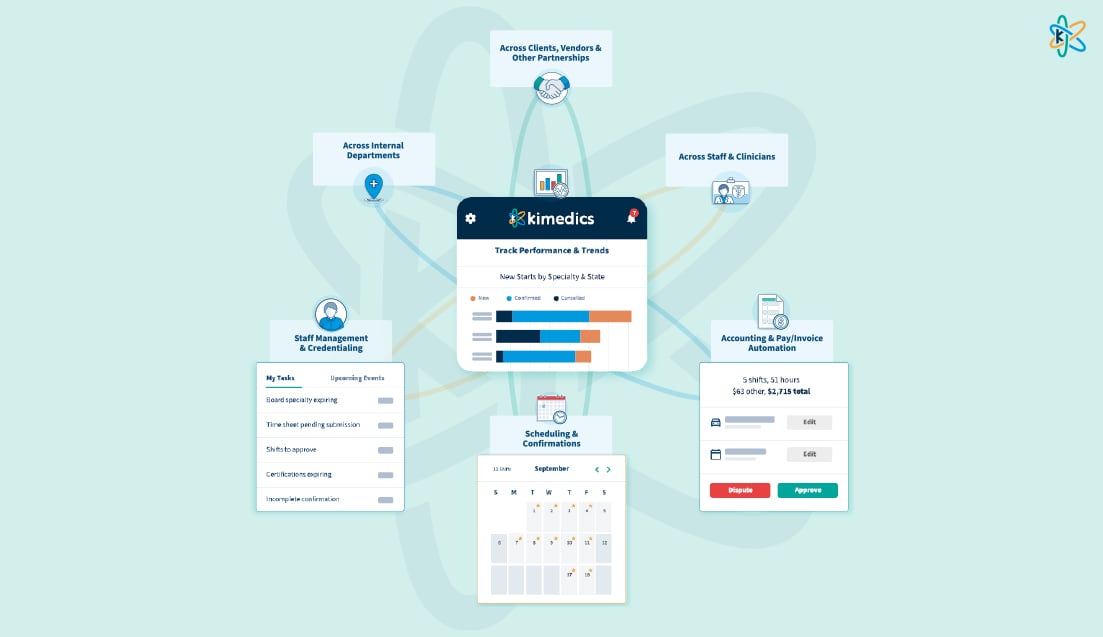Excellence in healthcare is a team effort, but having standout talent on staff can elevate outcomes for both patients and organizations. On the other hand, lower performers can stymie progress through disengagement, reluctance towards process improvements, and subpar delivery of care and financial implications if not adhering to billing/coding documentation processes. That's why actively identifying your highest flyers and those struggling to meet standards is so vital.
Consistently tracking performance across a spectrum of metrics enables you to nurture talent ready to take on leadership duties, spearhead change initiatives, and even transform how care is provided overall. Likewise, it allows persistent gaps to be addressed through focused training adjustments, workflow changes and increased supervision where warranted.
Want to know how to identify both high performers and low performers in your healthcare organization? We've got you covered, so let's get started!
Setting Your Criteria for High Performers and Low Performers
Before you can even consider identifying your high performers and low performers in healthcare, or any organization for that matter, you need to set some criteria. Here’s some advice that might help you out:
Define what excellence looks like
The first step to identifying high and low performers is establishing what excellence looks like for your healthcare organization. Avoid vague notions of exceptional talent. Rather, outline specific metrics, behaviors and competencies that exemplary clinical staff demonstrate day-in and day-out. These could encompass:
- Patient satisfaction – Percentiles scored on HCAHPS surveys, post-discharge call feedback, personalized thank you notes received
- Quality of care – Infection rates, 30-day readmission rates, survival rates for procedures performed, LOS
- Service delivery – Wait times, patient education provided, response rates to messages
- Colleague perspective – Peer review scores, willingness to support struggling coworkers
- Leadership – Track the number of times your leaders spearhead process improvement initiatives, speak up on safety issues, mentor new hires in specialty areas. You can also implement peer review scores to find out what peers think about leadership competencies like collaboration, communication, and teamwork. High scores indicate respect as a leader.
- Financial – Comparing work rvu/hour by day and night to ensure adhering to documentation and billing needs of the practice and to make sure that the practice is not over or understaffed.
Define ranges for exceeding, meeting, nearly meeting and falling below expectations for better segmentation. For example, physicians with over 95% satisfaction ratings, less than 5% readmissions and leading 1+ projects demonstrate admirable commitment.
Standardize criteria
With definitions for excellence set, standardized evaluation frameworks must then be established across specialties and care facilities so performance scoring allows for equivalent comparisons. This could include:
- Annual (or bi-annual) review formats assessing strengths and growth areas evenly
- Patient survey scoring methodology
- Quality indicator dashboards pulling from EHR systems
- Custom assessment forms for peer and supervisor evaluations
- Performance rubrics that map practice against protocol adherence, diagnostic accuracy etc.
The goal is unbiased and holistic visibility into every care provider’s contributions – both exemplary and needing improvement. Standardizing criteria is the foundation.
Automate reporting
Manual reporting and tracking of all the metrics that reflect healthcare staff performance is hugely cumbersome. That's why utilizing solutions that compile and analyze the data automatically is so invaluable - removing administrative workload while still supplying actionable insights.
Inventory all the systems currently housing relevant performance data - electronic health records, scheduling software, patient experience surveys, case management platforms, charge capture, billing, etc. Then investigate tools that can pull information from these systems automatically on a regular cadence.
Once you choose a tool, configure your preferred metrics to measure excellence. Automated reporting reduces legwork parsing data while still readily exposing high flyers and staff who might benefit from support.
3 Tips to Identify High Performers in Healthcare
Our top three tips for identifying high performers in your healthcare organization are:
1. Look for clinicians who consistently receive positive feedback and reviews from patients.
Specifically track patient satisfaction scores from surveys and personal testimonials. High performers tend to score over 90% positive scores consistently. Positive themes in reviews may cover good communication, caring bedside manner, patient education, coordination of care, clinic efficiency.
You can supplement surveys with in-person patient interviews to get added detail and insights into specific stand-out clinicians.
Then, you can consider award programs to recognize clinicians with the highest satisfaction marks as positive reinforcement.
2. Analyze quality metrics and clinical outcomes data.
Compile data on infection rates, mortality rates, readmission rates for top talent. Their outcomes will support benchmark goals.
You may also want to use disease-specific metrics like cancer remission rates or cardiac care survivorship rates based on treatment protocols. The best will have superior results.
Next, evaluate diagnostic accuracy rates in comparison to evidence-based standards to quantify patient impact. For surgeries, incorporate procedure duration, complications, and device performance as additional markers of skill.
Standardizing data reporting enables sound determinations of capability and areas for improvement.
3. Assess engagement and leadership behaviors.
Note who takes on informal or formal mentorship roles with colleagues and students. Sharing knowledge denotes comfort and skill. That said, a willingness to spearhead process improvement projects, safety initiatives, or serve on solutions-focused committees also shows initiative.
Further training and certifications reinforce commitment to personal growth and should be encouraged. When team members offer to do volunteer activities around health workshops or community education, it conveys passion for the broader mission. Finally, recognition from fellow team members and collaborative spirit are key cultural contributions.
Tracking these areas provides a well-rounded view - both qualitative and quantitative - to truly identify your most exemplary talent.
3 Tips to Identify Low Performers in Healthcare
Our top three tips for identifying low performers in your healthcare organization are:
1. Monitor for patient complaints and low satisfaction scores.
Consistently low satisfaction ratings below 75% should raise concerns. Common themes may cover poor communication, lack of compassion, errors, or incorrect diagnosis.
Review survey data at the individual practitioner level to surface those lagging behind cohort averages. Note the frequency of written complaints which can point to bedside manner or competency issues needing addressed through retraining or monitoring.
Low ratings limited to one area - e.g. communication skills - can guide tailored improvement programs. However, pervasive issues might imply deeper performance problems.
2. Track quality metrics over time.
An infection rate twice your organization's average warrants investigation, as does consistent readmission rates exceeding national benchmarks.
For physicians, quantify diagnostic accuracy rates compared to evidence-based guidelines - are they missing key indicators for disease screening or misdiagnosing conditions?
You may want to expand metrics to include operating room efficiency rates, wait times, and devices/implants functioning rates as applicable.
While an occasional bad outcome is understandable, patterns point to subpar patient care and system impact. Based on what you learn tracking quality metrics, we recommend addressing broader system issues contributing to gaps, while still holding individuals accountable.
3. Note disengagement and reluctance for development.
For example, a lack of willingness to adopt updated best practices or protocols reflects poorly on commitment. Not participating in training initiatives for new workflows or documentation systems is also problematic.
Additionally, team members that don’t volunteer for projects or staff committees aimed at progress can signal complacency. Keep an eye out for team members that display a general avoidance of leadership roles, isolation from staff groups, and resistance to feedback.
At some point, it may be time to reassess organizational fit. Some roles may be better suited to strengths and preferences - if no improvement despite support.
Proactive tracking and willingness to course correct are essential to uphold standards across all staff for organizational excellence. Patience and compassion are important when handling struggling employees too.
What to Do With All Your Data
Once you have identified your low performers and your high performers, what do you do with all of that data? Here are some ideas that might help:
Tailor development plans for everyone
With excellent and struggling performers identified through automated reporting, healthcare leaders can then tailor customized development opportunities based on strengths and weaknesses uncovered.
For those exceeding expectations already, this may include new leadership projects expanding their sphere of influence, incentives around teaching/training others to elevate team capabilities, and support earning specialty certifications or continued education.
Low performers however, will likely require training adjustments and increased supervision or protocol corrections to improve future patient interactions. Compassionate coaching and resolving underlying workplace barriers is key too. Consider cross-training high flyers to foster mentoring relationships as an additional avenue for growth.
The ultimate goal is matching the capabilities and preferences of talent to the right support trajectories for both emerging leaders and staff needing extra nurturing.
Dig deeper on low performers
Don't settle for just documenting subpar care delivered by struggling staff. Commit to understanding root causes impacting consistency, accuracy or patient interactions through things such as:
- Increased chart review to pinpoint diagnostic or procedural patterns
- Anonymous peer discussions on potential weak points
- One-on-one supervised sessions for direct recommendations
- Patient testimonials detailing where poor care originated
- Assessing external realities like staffing ratios, lack of technology etc.
Design patient safety initiatives and workflow changes to better support gaps uncovered. However, balance system improvements with individualized training, protocols and expectations for those requiring more hands-on development. Document clear action plans listing the support resources now available.
Consider high performers for leadership roles
Leadership potential stretches beyond just managers and physicians. Assess key contributors across all roles exhibiting behaviors like:
- Mentoring new staff members to build capabilities
- Volunteering solutions for process improvement projects
- Modeling work ethic and engagement for the broader team
- Speaking up on safety concerns and encouraging transparency
- Demonstrating willingness to learn new workflows and technologies.
Track participation and effort towards elevating department objectives to uncover emerging leaders ready for growth opportunities, in addition to current formal managers. Talent taking initiative signifies your influencers of tomorrow.
Identify Red Flags in the Workforce with Kimedics
Tracking performance can feel like adding an additional full time job to already overburdened administrators. We recommend you use Kimedics's shift analysis and forecasting tools to identify red flags within your healthcare workforce. Want to learn more about how we can help you? Click here to schedule a demo today!


